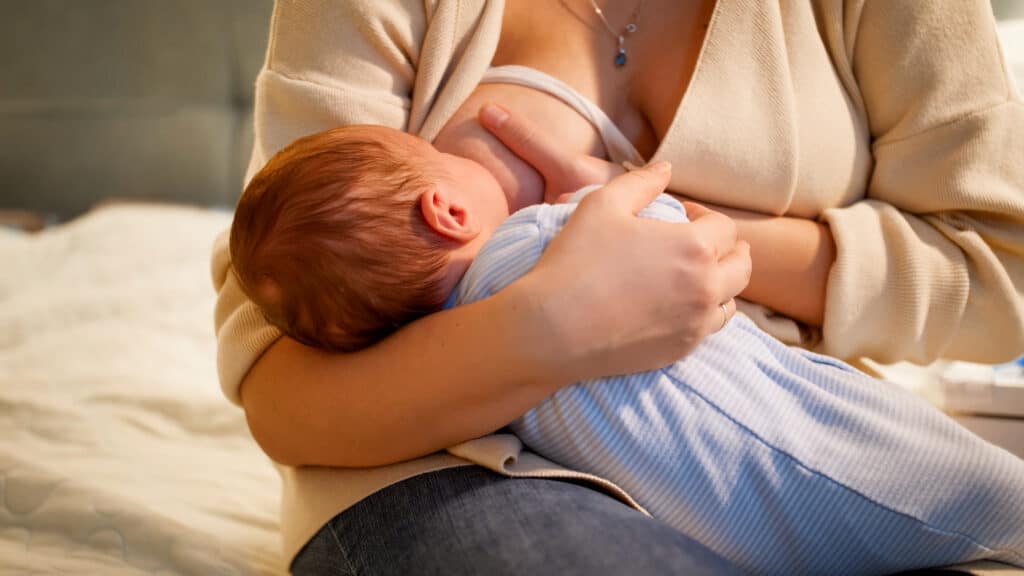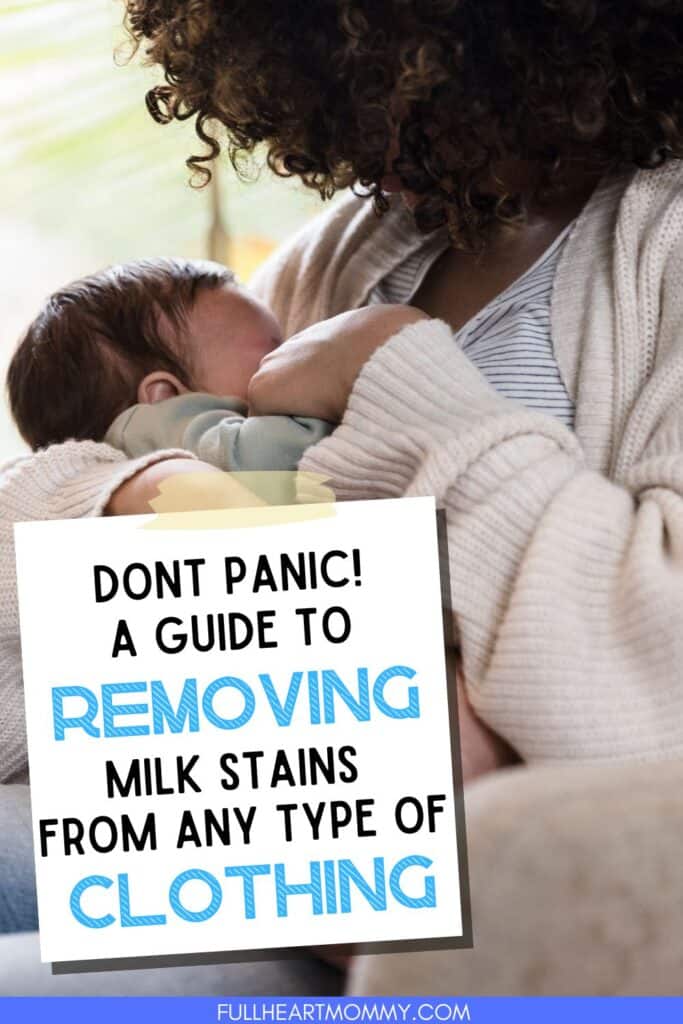Yes, breastmilk can indeed stain clothing. Whether it’s a new outfit or a well-worn onesie, milk stains can be stubborn and persistent if not treated properly.
Breastmilk is composed of fats and proteins which, when exposed to air, can break down and oxidize, producing yellowish-white stains on clothing. The milk’s fat content also makes it more challenging to remove since ordinary laundry detergents can have difficulty penetrating the lipids.
On top of that, many babies tend to be a bit messy while they feed, making the chances of getting milk on clothes even higher! These factors combine to make breastmilk one of the most difficult stains to remove from fabric.
Fortunately, there are some tried-and-true methods for getting rid of the pesky yellowish-white mess that often accompanies a happy feeding time.
In this blog post, we’ll dive deeper into what you should know about breastmilk stains and provide tips on how to tackle them head on.

How To Remove Breastmilk Stains From Clothing
Although removing breastmilk stains from clothing and baby clothes is not always easy, there are a few steps you can take to ensure the best results.
Make sure you have all the necessary supplies first. You will want:
-A soft bristled brush
-Stain remover for pretreatment
-Enzymatic laundry detergent
Don’t be put off by the enzymatic laundry detergent, this just means it is a detergent designed to break down proteins(like the ones in breastmilk stains) and remove stains from clothing.
Some popular names of enzymatic laundry detergent include Tide Plus Ultra Stain Release, OxiClean High Def Clean detergent, Gain Original Coldwater Liquid Detergent, Era PLUS Oxiboost Liquid Laundry Detergent, and All Small & Mighty 3x concentrated.
- First, soak the clothing in cold water. Cold water prevents the stain from setting in and slowing down enzymatic activity and further staining.
- Next, pre-treat the stain with an enzyme detergent or a spot treatment. Rub it into the fabric with the soft bristle brush. Allow the pre-treatment to soak into the fabric for 10-15 minutes before laundering.
- Finally, launder in cold water with a regular laundry detergent that contains enzymes and allow garments to air dry. For tougher stains, repeat the process as needed.
What About Colostrum?
Colostrum is the first milk produced after giving birth. It is a yellowish fluid that contains nutrients, and antibodies needed for young babies to survive and develop.
While colostrum does contain proteins, it doesn’t typically cause staining of clothing due to its lower fat content. However, it’s always a good idea to clean any spills immediately as colostrum can eventually cause discoloration if left untreated.
How To Prevent Breastmilk Stains
To prevent breastmilk stains from appearing on clothing, wear nursing pads in your bra. This will absorb any leaks and avoid potential staining.
Additionally, place a receiving blanket or burp cloth over yourself and your baby when feeding as this can help catch any milk that doesn’t make it into your baby’s mouth.
Try to treat the stain as soon as you notice it but if this is not possible, try to blot the stain with a paper towel or cloth.
Related: How Many Burp Cloths Do I Need?
Set In Breastmilk Stains Vs Fresh Breastmilk Stains
Yes, set-in breastmilk stains are generally harder to remove than fresh breastmilk stains. Luckily, the process for removal is the same. The process might require a little more elbow grease with the pre treatment scrubbing or repeating cycles.
Breastmilk Stains and Furniture
It may be inevitable that breastmilk stains your furniture. If it does, removing breast milk stains from furniture can be tricky, but it’s not impossible. The first step is to treat the area with a mixture of equal parts white vinegar and cold water, which can help break down the proteins in the milk.
Once the area has been soaked, use a soft cloth or sponge to gently rub liquid laundry soap into the stain. Let it sit for 5-10 minutes before blotting away with a damp rag.
For more persistent stains, pretreat with enzyme-based cleaners before scrubbing with a soft bristle brush with a gentle detergent and cold water. Finally, let the area dry completely before returning any furniture cushions or covering back in place.
FAQ
What does a milk stain look like?
A milk stain typically looks wet and yellowish or white in color. It can also be sticky to the touch and often have a sour smell.
Milk stains can sometimes be difficult to detect, so if you think your baby’s clothes may have been stained with milk, it’s important to check for any discolorations or wet spots on fabric which could indicate a potential stain.
Does vinegar remove milk stains?
Yes, vinegar can help to remove breast milk stains from clothing. To do this, mix together equal parts white vinegar and cold water and soak the stain for 15-20 minutes.
Afterward, pretreat the stain with a liquid laundry soap or spray and let it sit for 5-10 minutes before laundering as usual.
For more stubborn set-in stains, use an enzymatic cleaner like borax or OxiClean to help break down and lift the stain.
Finally, always use cold water when removing breast milk stains from clothing for best results.
Does milk stain smell go away?
Milk stains can often have a sour smell, which may linger even after the stain has been removed. Using an enzyme-based cleaner such as borax or OxiClean to pretreat the area before laundering can help break down and lift the proteins in the milk that cause odors.
Additionally, adding 1/2 cup of white vinegar to your wash cycle can help to neutralize any sour smells. Finally, always use cold water when washing stained clothes for the best results.
There are several ways to remove and prevent breastmilk stains from fabrics like clothing, baby clothes, and furniture. The most important thing is to catch any stains as soon as possible.
Then, use a mixture of white vinegar and water, an enzyme-based cleaner, or liquid laundry soap to pretreat the stain before laundering.
Finally, always use cold water when removing breast milk stains from clothing for best results. With these tips, you can help to keep your fabrics looking and smelling like new.


